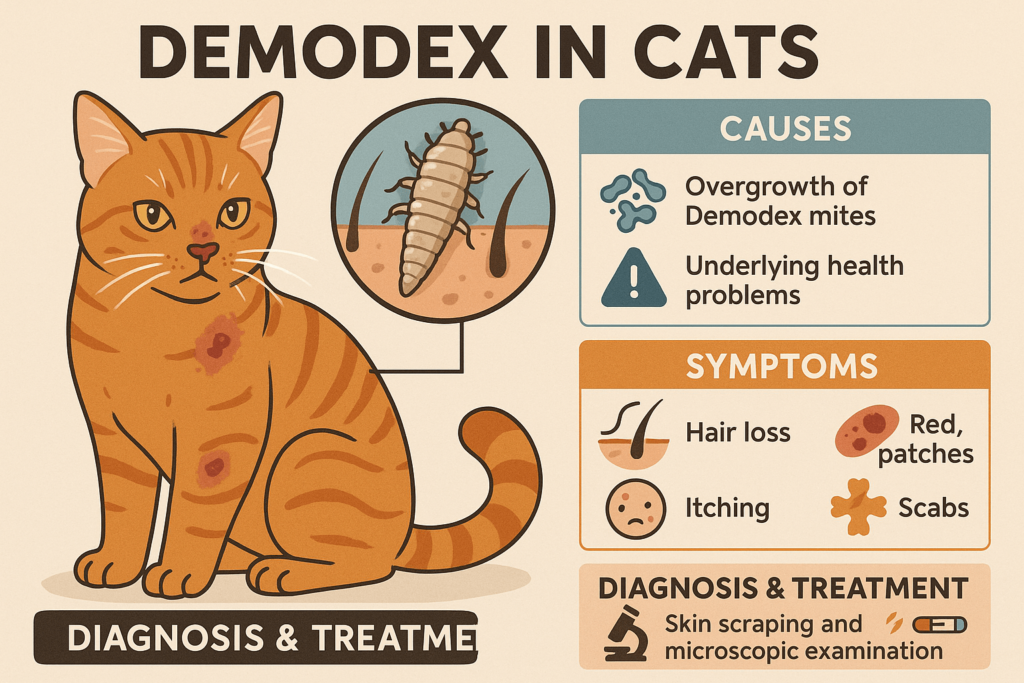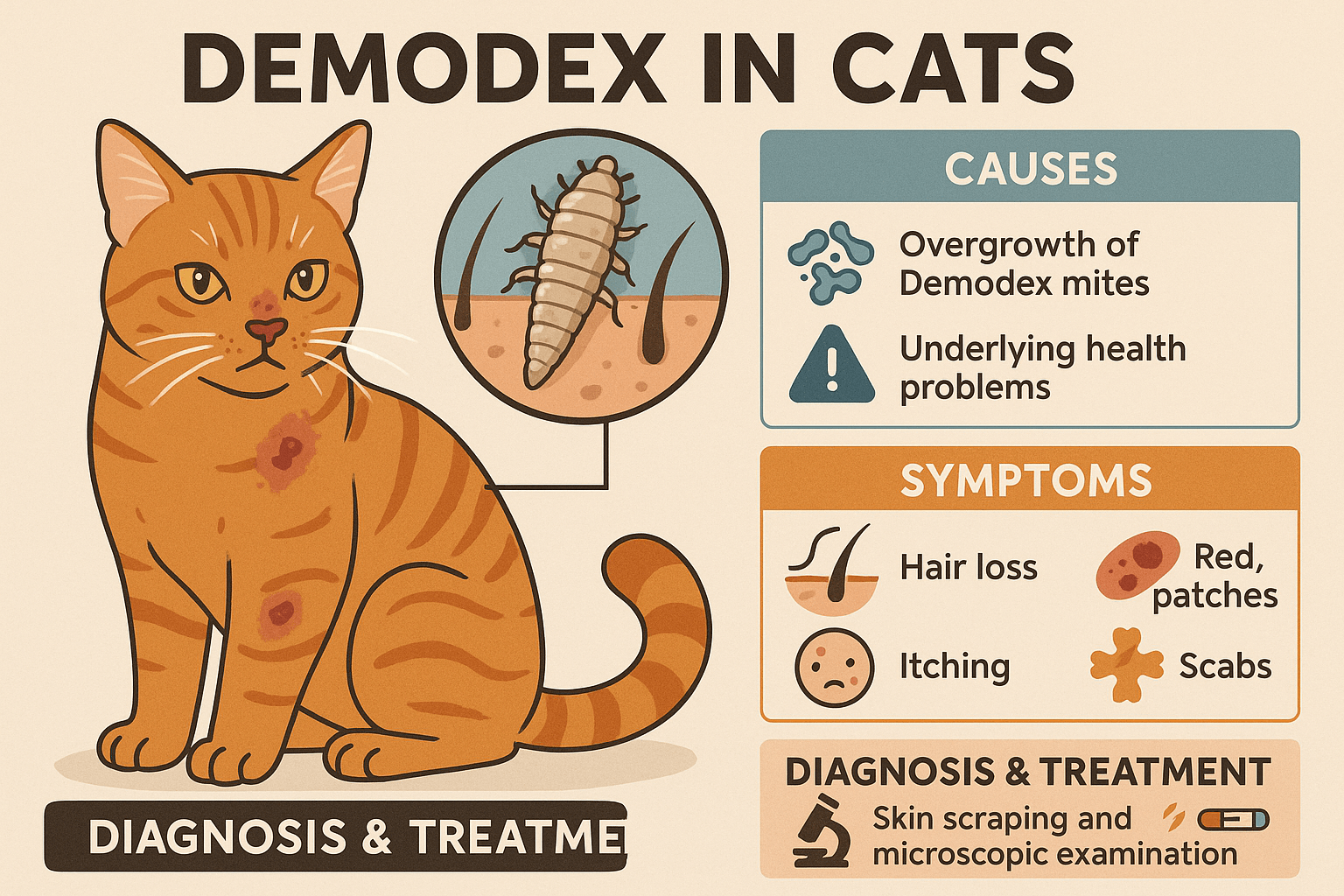Demodex in Cats: What You Need to Know
Demodex in cats is a condition caused by microscopic mites that live in the hair follicles and skin of felines. While these mites are naturally present on most cats, an overgrowth can lead to health issues such as hair loss, itching, and skin irritation. Understanding the causes, symptoms, and treatment options for demodicosis (the disease caused by Demodex mites) is crucial for ensuring your cat’s well-being. In this blog post, we’ll explore everything you need to know about Demodex in cats, from identifying the signs to managing the condition effectively.
Understanding the Causes of Demodex in Cats
Demodex mites are a normal part of a cat’s skin flora, but certain factors can trigger an overpopulation, leading to demodicosis. Identifying these underlying causes is key to preventing or managing the condition.
Weakened Immune System:
A compromised immune system can allow Demodex mites to multiply unchecked, making kittens and senior cats more susceptible.Stress and Environmental Changes:
Stressful situations, such as moving homes or introducing new pets, can weaken a cat’s immunity and contribute to mite overgrowth.Underlying Health Conditions:
Diseases like diabetes, cancer, or hormonal imbalances may create an environment where Demodex thrives.Poor Nutrition:
A diet lacking essential nutrients can weaken a cat’s immune defenses, increasing the risk of demodicosis.Genetic Predisposition:
Some cats may be genetically prone to mite infestations due to inherited immune system weaknesses.
By addressing these contributing factors, you can reduce the likelihood of Demodex becoming a problem for your cat.

Recognizing the Symptoms of Demodex in Cats
Early detection of Demodex in cats is vital for effective treatment. Look out for these common signs that may indicate a mite infestation.
Patchy Hair Loss:
One of the most noticeable symptoms is localized or widespread bald patches, often around the face, neck, or legs.Itchy Skin:
While not all cats with Demodex will itch excessively, some may scratch or bite at affected areas due to irritation.Red or Inflamed Skin:
Infested areas may appear red, swollen, or scaly, signaling inflammation caused by the mites.Oily or Greasy Coat:
An overproduction of sebum can result in an unusually oily coat texture, which is sometimes linked to Demodex infestations.Secondary Infections:
Bacterial or fungal infections may develop in severe cases, worsening the condition and requiring additional treatment.
If you notice any of these symptoms, consult your veterinarian promptly to confirm the diagnosis and begin appropriate care.
Check this guide 👉How to Check for Ear Mites in Cats: Best 7 Expert Tips!
Check this guide 👉How Do Indoor Cats Get Ear Mites? Best 7 Expert Tips!
Check this guide 👉Understanding Cat Chin Mites vs Acne: Best 7 Expert Tips!
Preventive Measures for Demodex | Treatment Options for Demodicosis |
|---|---|
Maintain a balanced diet | Topical medications prescribed by vets |
Minimize stress triggers | Oral antibiotics for secondary infections |
Regular grooming and hygiene | Medicated shampoos to soothe irritated skin |
Routine vet check-ups | Lime sulfur dips for severe cases |
Address underlying health conditions | Boosting immunity through supplements |
How to Diagnose Demodex in Cats
Proper diagnosis is essential for distinguishing Demodex from other skin conditions that share similar symptoms. Here’s how veterinarians typically identify a Demodex infestation.
Skin Scraping Test:
A small sample of skin is scraped and examined under a microscope to detect mites or their eggs.Hair Pluck Analysis:
In some cases, hairs are plucked from affected areas and analyzed for signs of mite activity.Physical Examination:
Vets assess visible symptoms like hair loss and inflammation to narrow down potential causes.Blood Tests:
Blood work may be performed to rule out underlying health issues contributing to the infestation.Response to Treatment:
If initial treatments improve the condition, it can help confirm the presence of Demodex mites.
Accurate diagnosis ensures targeted treatment, improving your cat’s chances of recovery.
Tips for Managing Demodex at Home
Once your cat has been diagnosed with Demodex, there are several ways you can support their recovery and prevent recurrence.
Follow Veterinary Advice:
Adhere strictly to the treatment plan prescribed by your vet, including medication schedules and follow-up visits.Keep Their Environment Clean:
Wash bedding, toys, and grooming tools regularly to eliminate mites and prevent reinfestation.Provide Nutritious Food:
Feed your cat a high-quality diet rich in vitamins and minerals to strengthen their immune system.Monitor Progress Closely:
Track changes in your cat’s skin and coat condition, reporting any concerns to your vet immediately.Limit Contact with Other Pets:
Isolate your cat temporarily to prevent spreading mites to other animals in the household.
With proper care and attention, most cats recover fully from Demodex infestations.
Common Misconceptions About Demodex
There are many myths surrounding Demodex in cats, which can lead to confusion and improper care. Clearing up these misconceptions helps ensure better outcomes for affected cats.
Myth: All Cats Show Obvious Symptoms:
Some cats carry Demodex mites without showing any signs, making regular vet check-ups important.Myth: Demodex Is Always Fatal:
Most cases are treatable, especially when caught early and managed properly.Myth: Bathing Alone Will Cure It:
While bathing helps, it’s not enough to eliminate mites completely—professional treatment is necessary.Myth: Only Outdoor Cats Get Demodex:
Indoor cats can also develop demodicosis, particularly if they have weakened immune systems.Myth: Prevention Is Impossible:
Maintaining good health and hygiene significantly reduces the risk of infestations.
Dispelling these myths empowers cat owners to make informed decisions about their pet’s care.
Supporting Your Cat’s Immune System
A strong immune system plays a critical role in preventing and managing Demodex infestations. Here are ways to boost your cat’s natural defenses.
Feed High-Quality Protein:
Protein-rich diets support tissue repair and overall immune function.Include Omega-3 Fatty Acids:
Supplements or foods containing omega-3s promote healthy skin and reduce inflammation.Ensure Adequate Hydration:
Proper hydration supports detoxification processes and keeps skin supple.Minimize Exposure to Toxins:
Avoid using harsh chemicals in your home that could irritate your cat’s skin or weaken their immunity.Encourage Exercise and Play:
Physical activity stimulates circulation and enhances overall wellness.
By prioritizing your cat’s immune health, you create a solid foundation for fighting off mites and other ailments.
When to Seek Emergency Veterinary Care
While many cases of Demodex are manageable, certain situations require immediate veterinary attention. Knowing when to act quickly can save your cat’s life.
Severe Hair Loss Across the Body:
Widespread alopecia indicates advanced infestation and requires urgent intervention.Open Sores or Bleeding:
Broken skin increases the risk of infection and demands prompt medical care.Lethargy or Loss of Appetite:
These signs suggest systemic illness, possibly triggered by Demodex or another underlying issue.Swollen Lymph Nodes:
Enlarged lymph nodes may signal a serious immune response needing professional evaluation.Sudden Worsening of Symptoms:
Rapid progression of symptoms warrants an emergency vet visit to prevent complications.
Recognizing these warning signs ensures timely treatment and improves your cat’s prognosis.
Frequently Asked Questions About Demodex in Cats
Can Demodex spread to humans?
No, Demodex mites are species-specific and cannot infect humans.
Is Demodex contagious between cats?
While rare, direct transmission can occur, especially in kittens or immunocompromised cats.
How long does treatment take?
Treatment duration varies but typically lasts several weeks to months, depending on severity.
Can I use over-the-counter products?
Avoid self-medicating; always consult a vet for safe and effective treatments.
Will my cat’s fur grow back?
Yes, once the infestation is treated, fur usually regrows within a few months.
Taking Action Against Demodex in Cats
Demodex in cats may seem daunting, but with early detection, proper treatment, and ongoing care, most cases resolve successfully. By staying vigilant for symptoms, working closely with your veterinarian, and maintaining a healthy lifestyle for your cat, you can minimize the impact of this condition. Remember, your feline friend relies on you to advocate for their health—so don’t hesitate to seek professional guidance whenever needed. With love and proactive care, your cat can overcome Demodex and enjoy a happy, itch-free life.
Canned Pumpkin for Cat Diarrhea: Best 7 Expert Tips! Natural remedy to firm stools, soothe upset bellies, and support gut health safely.
Can a Cat Give You Scabies? Best 7 Expert Tips! Discover the truth about feline mites, human skin risks, and how to protect yourself—without panic.
Cat Flea vs Human Flea: Best 7 Expert Tips! Discover the truth about bites, species, and how to eliminate infestations for good.
Weird Cat Behaviors: Best 7 Expert Tips! Discover why cats do strange things—and how to understand, not punish, their instincts for a happier home.





